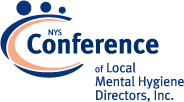NYS Conference of Local Mental Hygiene Directors, Inc. | An Affiliate of the New York State Association of Counties >
Hot Topics / Priority Issues
United Hospital Fund: Lessons from the Great Recession - How Medicaid Enrollment Patterns of a Decade Ago Can Inform Policy During the Pandemic
NEW YORK, NY—June 9, 2020—A HealthWatch report released today by United Hospital Fund (UHF) analyzes New York State Medicaid enrollment trends during the “Great Recession” of 2007-2009, and the impact of state and federal actions taken then, in order to shed light on what to expect during the current pandemic-sparked economic downturn.
The state’s estimated unemployment rate nearly doubled between 2007 and 2009, growing from 4.8 percent in December 2007 to a peak of 8.9 percent in November 2009. Medicaid enrollment grew by over 400,000 individuals during the same period, a 10 percent increase. But as the economy recovered and unemployment rates returned to pre-recession levels, Medicaid enrollment continued to grow. Ten years later, nearly 6 million people are enrolled as of October 2019—roughly one-third of the state’s residents and 2 million more than were covered in December 2007.
The report, Lessons from the Great Recession: New York Medicaid Enrollment During the COVID-19 Crisis,observes that, if job losses in 2020 are initially concentrated among low-income New Yorkers, Medicaid enrollment may grow somewhat more modestly than during the previous downturn because many may already be enrolled in the program.
However, more widespread unemployment that disrupts the health coverage of higher income people and depresses their incomes below Medicaid eligibility thresholds could drive larger increases in Medicaid enrollment—for instance, in households where COBRA premiums become unaffordable and where monthly incomes fall below the ranges for enrollment into other publicly financed health programs. The pandemic itself may also hasten enrollment, as newly uninsured individuals seek affordable coverage for COVID-19 testing and treatment. Early reports from the New York State Department of Health suggest that the enrollment growth rate since February 2020 has been four times the average monthly growth rate during the first year of the Great Recession.
“The COVID-19 pandemic will likely shape New Yorkers’ need for coverage in unprecedented ways, and the state will face daunting challenges in facilitating Medicaid enrollment during a major public health crisis,” said Nathan Myers, director of UHF’s Medicaid Institute and a co-author of the report. “But Medicaid will remain a vital source of coverage, and sustaining and building on New York’s progress in improving access to Medicaid will be crucial for serving those in need during these uncertain times.”
New York took several steps to expand Medicaid eligibility and facilitate enrollment during the Great Recession, including eliminating asset tests for children and nondisabled adults and reducing administrative barriers such as face-to-face interviews. These actions complemented more recent Affordable Care Act provisions, including streamlined Medicaid income rules, expansion to a new group of childless adults, and implementation of the New York State of Health online insurance marketplace. Together, these changes will continue to support New Yorkers’ access to Medicaid during the COVID-19 pandemic.
Looking ahead, several other Medicaid features and strategies could be critical for supporting individuals seeking coverage during the COVID-19 emergency, the report says. These include further leveraging presumptive eligibility, which allows hospitals, clinics, and local health departments to grant temporary Medicaid coverage to income-screened individuals while their full applications are pending. As the entire nation combats COVID-19, New York might also draw lessons from other states that have expanded access to Medicaid coverage, the report suggests.
Lessons from the Great Recession: New York Medicaid Enrollment During the COVID-19 Crisis was also co-authored by Emily Arsen, UHF senior research analyst, and Sarah Scaffidi, UHF research analyst, along with Nathan Myers. It is available at UHF’s website here. Also available on the website is a free consumer guide produced by UHF with practical advice about obtaining or maintaining Medicaid and other health coverage during the current crisis, Grim Times and Health Insurance: Maintaining Coverage During the Pandemic.
About United Hospital Fund
United Hospital Fund works to build a more effective health care system for every New Yorker. An independent, nonprofit organization, we analyze public policy to inform decision-makers, find common ground among diverse stakeholders, and develop and support innovative programs that improve the quality, accessibility, affordability, and experience of patient care. For more on our initiatives and programs please visit our website at www.uhfnyc.org and follow us on Twitter.



